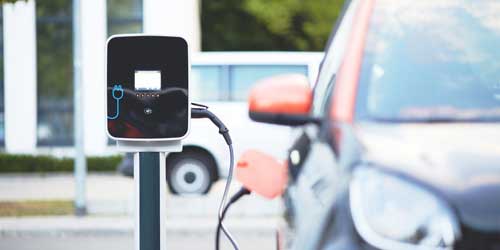The Type of Road You’re Driving On
As well as the terrain of the part of the country you are driving on the type of road it is can impact your range.
By road type we mean whether it is a B road, A road or motorway as well as whether the road’s design.
Faster speeds mean a higher energy demand which typically means that drivers who are regularly on dual carriageways or motorways where the average speed is higher and there is more acceleration which again needs more energy.
If you’re driving in towns with a lot of stop-start traffic you might also see an impact from the frequent braking and acceleration of the vehicle, which will mean you’ll have a slightly lower range compared to a journey where you travel consistently at the same speed.
Similarly, winding roads with a high speed limit, which are common in the British countryside, will usually see a lot of braking and then acceleration which will have the same impact on your range.

The Weather
It’s not something you initially think of having an impact on your car other than needing to use your windscreen wipers when it’s raining but the weather can actually have a pretty large impact on your vehicle.
Even in a petrol or diesel car your battery will be affected by the cold weather, as the cold inhibits the flow of electrons in the battery and so reduces the battery effectiveness and life span. This is why you often find that even with your traditional combustion engine your battery is more likely to go flat in the winter.
Electric vehicles are usually more efficient than a combustion engine in their energy production, however this means that you do not get the same heat by-product that you do with a combustion engine which helps warm the engine and heat the interior. In an EV power will need to be dedicated towards heating and more power on activities such as clearing the windscreen.
EVs may also have a dedicated heating / cooling system for the battery to keep it at the optimum temperature no matter how warm or cold it is outside. This additional feature will require energy and so take it away from the mileage.
It’s not just the engine that might need to cool down on a hot day though, when the sun is out drivers are more likely to turn on the AC. This is another extra feature that uses power and so takes potential energy away from the electric motor and reduces your expected range. Alternatively, drivers might choose to open their windows for a fresh breeze. This can also have an impact on the mileage range as it adds additional drag on the vehicle and so you need more power to reach the same speed.
Wind
No matter what the temperature is wind can have a massive impact on your range. Even if you aren’t driving with the windows down the additional resistance on your vehicle on a particularly windy day means more power is needed to drive at your usual speeds, again reducing the range you can achieve between charges.
There’s little any of us can do about the weather but it’s an important thing to be aware of when you’re looking at a new EV for your next company car.
Using Ancillary Features
You might think of them as essential but features like:
- The radio
- Windscreen wipers
- Heating
- Air conditioning
- Phone connectivity
- Lights
- Heated seats
Will use energy that is being allocated to the battery range, and so the more you use these features as you drive the less you will be able to travel between charges.
This difference will usually only be noticeable if there are other factors in play as well and it will usually only be a decrease of a few miles. As the impact is minimal we wouldn’t suggest altering your use of these features unless you find they are draining a lot of energy from the battery.
Tyre Condition
Although EVs don’t have as many components so have less general wear and tear on the vehicle one part they have equal wear to a petrol / diesel car is the tyres.
You should regularly check your tyres as good tyre condition helps avoid more wear on other parts of the vehicle, reduce the risk of an accident due to poor tread or a tyre bursting, and increases the efficiency of your vehicle – which means a larger range for an EV.
EV Battery Condition
The condition of your battery has an impact on the power it can hold. Just like a traditional combustion engine vehicle the battery in an EV is affected by general aging as well as the numerous charge cycles it will go through can eventually lead to the energy it can store decreasing. However, due to the technology used in modern EVs this is not something that you will see have a massive impact on your available range, but we do think it’s important to bear in mind long term as you might see a small and gradual decrease over the years.
Beginning Charge Level
Depending on what your starting percentage is you might also spot a small difference in the mileage range you are able to achieve in the vehicle. The optimum range of charge in general is between 20 and 80 per cent, as frequently running your battery too low or
What’s a Realistic EV Range?
The range an EV is advertised with is achievable if you are very careful with your driving style and habits, the weight of goods and passengers you carry, the weather and roads you are driving on and the other factors listed above. We would realistically expect to achieve around 80 to 90 per cent of the advertised range without you needing to place restrictions on yourself or your vehicle to achieve the optimum range.
What Happens if Your Electric Car Battery Runs Out?
Just like a fuel gauge on a petrol or diesel car your EV will give you a mileage range and let you know when it is getting low on charge. You should pay attention to this and charge the vehicle as soon as you are able to before the battery runs flat.
If your battery runs flat then you will need to contact your breakdown provider and ask for a flatbed truck to take you to the nearest charging station. Please note that EVs shouldn't be towed as this can damage the traction motors used in the regenerative braking process and as towing is often the default recovery method you will need to specify that a flatbed truck is needed for your EV.
Wessex Fleet's Tips to Improve Your Electric Car's Range
1. Anticipate what's ahead - to try and avoid harsh braking where you'll lose power you are unable to recapture with regenerative braking.
2. Slow down - travelling at higher speeds requires more power and so will use the battery power quicker than if you travelled a little slower.
3. Keep it light - if you have heavy items in the vehicle that aren't required for that journey then take them out. The heavier the car is the more power it will take to move it and the quicker your battery will deplete.
4. Turn down the heat - reducing your use of the heating / air conditioning, radio and other ancillary features will stop them from using up battery power that could be used to extend your range by a few miles.
5. Check your wheels - keeping the tyres in good condition will help keep the car in the best running condition and helps provide you with the best fuel economy, even in an EV.
For more of our electric guides click here or head back to our driver homepage for all our other helpful content.




